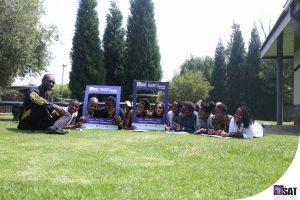Post the most traumatic moments of my life (aka the PhD), I jumped with enthusiasm into the civil society space where I was given an exciting challenge to develop youth programmes in sexual and reproductive health (SRHR). We’re coolly known as #SAT4YOUTH! The journey has meant learning to apply theory, and designing programmes to plant the seeds and enable powerful youth agency and advocacy!
#SAT4YOUTH has three core components, namely, supporting youth to meaningfully engage (and for real, not the two-minute Malala Yousafzai address at the 2015 Sustainable Development Goals Summit in New York), post conference participation e.g. report-writing, vlogging but also a leadership programme aimed at creating #YouthQuake in SRHR.
Now for those of you, who for whatever reason on earth (probably a really uncool one), don’t know what “YouthQuake” means, it was officially named the 2017 word of the year by Oxford Dictionaries. So to keep up with the times let me spell it out for you: YouthQuake = significant cultural, political, or social change arising from the actions or influence of young people. Now I don’t know about you, but I reckon that’s exactly what’s needed to uproot gender inequality and health systems research (the Emerging Voices way, sorry, uhm, bias in check) but also to create the Africa we so desperately need and want!
On that note, we coupled blogging expertise (the real Shakira), youth from across Africa and the ever-so –hip-young diplomat and significant contributor to the African Union (AU) Youth Division – Kokou Sename. During the interview, youth were starry-eyed as they learnt the art of blogging but also engaged with a top level diplomat around youth power, leadership (Kokou is probably the next head of the AU, or so we hope) and what we should consider before starting #YouthQuakes!

Young Leader – AU Engagement Groundies Left to Right; Kokou Sename, Akende Simamuna, Raymond Mazhambe, Hastings Banda, Linly Dumuka, Shakira Choonara, Patricia Hamura, Beverly Chogo, Millicent Sethaile, Tambudzai Magwenzi and Bosa Sabele
In case you didn’t know, a “groundie” is a portrait photograph taken when you lie on the ground.
Below are the types of questions youth were interested in and Kokou’s revolutionary responses.
I am thirty years old, I started as a young leader and moved across different sectors all the way to the national level and now I’m in the AU serving 44 countries in Africa; for me it’s definitely a way of having more impact and responding to the needs of young people. At the core of my work is strengthening the AU Youth Division, where we need to ensure an AU common agenda on youth, building capacity and partnering on interventions to include issues of gender and the demographic dividend. The AU actually declared 2017 “the year of harnessing the Demographic Dividend” but I don’t hear many speaking about this, so that’s what my core work entails i.e. taking these high level commitments and making them accessible, capacitating youth and ensuring it becomes a reality.
The AU Youth Charter was actually adopted in 2006, but only in January this year it was decided to ratify the charter. Young voices and their contribution are very important. We will assess the AU Youth charter which will feed into a decade plan of action 2009 -2018 – assessment this year. It’s a nice intervention, a continuum of advocacy and a strong mechanism where you can hold people accountable. If I promise to bring you tea and I don’t, you will ask me, but if I don’t promise you, you can’t really hold me accountable. Someone has to put pressure to push to implementation and monitor.
A reform of the AU was called for, and led by President Kagame, the current AU chair. Part of the reform is to improve the number of youth representatives. The AU will soon comprise a 35 percent youth workforce, and we surely need these youth. We all face that job dilemma where you’re qualified but not considered to have sufficient experience; part of our programme is to allow for youth to be deployed to different countries (yes, they do receive a stipend!) and gain work experience. I also began my career in the programme, so yes, it is getting better.
Thinking of the word, I tried to compare it with an earthquake and considered what happens when there is an earthquake. Part of that answer lies in those who will shake things up. Either you “have” a disaster or you will harness it, it needs to be way innovative, you need the thinking – and outcomes. Sometimes we miss out what will happen with innovative/ critical questions. Don’t accept, borrow or steal; improve and find better ways!
So I’m not sure about you, but clearly, this is the beginning of massive change the continent will see, groundies have paved the way for new methods of engagement which I also hope to see at the Health Systems Global conference in Liverpool this year (although, if I’m given another poster presentation, will probably boycott in the name of meaningful youth engagement)!
All opinions expressed in the blog are that of the author and not the SRHR Africa Trust